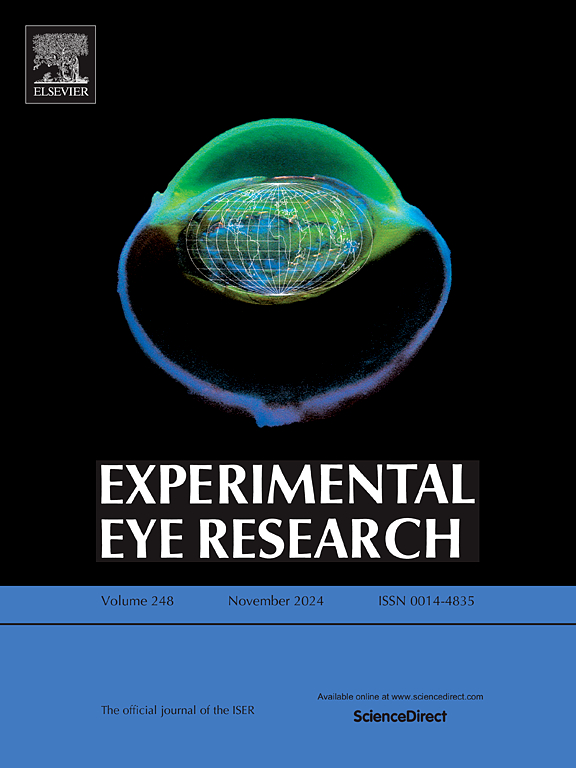Sigma-2调节剂CT2074在眼压过高小鼠模型中的神经保护作用
IF 3
2区 医学
Q1 OPHTHALMOLOGY
引用次数: 0
摘要
眼部神经退行性疾病,尤其是青光眼,是全球失明的重要原因之一,目前的疗法不足以解决视网膜和视神经的退化问题。最近的研究发现,sigma-2 受体是一种潜在的药物靶点,可为治疗眼部神经退行性疾病提供神经保护。本研究在原发性开角型青光眼小鼠模型中研究了σ-2受体调节剂CT2074的神经保护潜力。雄性小鼠在单侧磁珠诱导下眼压升高,每天口服 CT2074,从诱导眼压升高前三天开始,持续三周。小鼠双侧眼内注射霍乱毒素 B-488(CTB),以评估视网膜神经节细胞(RGC)的逆行运输。在诱导OHT三周后收集视网膜、视神经和脑组织,以量化RGC和轴突数量,并保留对侧视网膜和脑组织以评估药物暴露情况。在视网膜中观察到的 CT2074 水平超过了 95% 的受体占用浓度。与正常组和 CT2074 组相比,车辆组的 RGC 数量明显减少。值得注意的是,CT2074 治疗组的 RGC 密度明显高于车辆组(p本文章由计算机程序翻译,如有差异,请以英文原文为准。
Neuroprotective effect of Sigma-2 modulator CT2074 in a mouse model of ocular hypertension
Ocular neurodegenerative diseases, particularly glaucoma, represent a significant global cause of blindness, with current therapies inadequately addressing the degeneration of the retina and optic nerve. Recent research has identified the sigma-2 receptors as a potential druggable target to offer neuroprotection in managing ocular neurodegenerative disorders. This study investigates the neuroprotective potential of CT2074, a sigma-2 receptor modulator, in a mouse model of primary open-angle glaucoma.
Male mice were subjected to unilateral magnetic bead-induced elevation of intraocular pressure (IOP) and received daily oral administration of CT2074, commencing three days prior to ocular hypertension (OHT) induction, and continuing for three weeks. Mice received bilateral intraocular injections of cholera toxin B-488 (CTB) to assess retinal ganglion cell (RGC) anterograde transport. Retina, optic nerve, and brain tissues were collected three weeks post OHT induction for quantification of RGC and axon number, with contralateral retinas and cerebelli preserved for assessment of drug exposure.
CT2074 was observed in the retina at levels exceeding the 95% receptor occupancy concentration. RGC quantification showed a significant reduction in the Vehicle group compared to Naïve and CT2074 groups. Notably, the CT2074 treatment group exhibited significantly higher RGC density than the Vehicle (p < 0.0001) and was no different than Naïve. Analysis of RGC axons in optic nerve cross-sections revealed significant axonal loss in both the Vehicle and CT2074 groups compared to Naïve, though the CT2074-treated group had significantly higher axon number compared to the Vehicle. Anterograde transport in the Vehicle and CT2074 groups did not differ.
This study underscores the potential of CT2074 administered orally to protect RGCs exposed to elevated IOP, as evidenced by substantial preservation of RGCs and their axons compared to Vehicle-treated mice. These findings signify a promising avenue for the development of sigma-2 receptor-targeted therapeutics in glaucoma and related neurodegenerative diseases, addressing a critical unmet need in the field of ocular neuroprotection.
求助全文
通过发布文献求助,成功后即可免费获取论文全文。
去求助
来源期刊

Experimental eye research
医学-眼科学
CiteScore
6.80
自引率
5.90%
发文量
323
审稿时长
66 days
期刊介绍:
The primary goal of Experimental Eye Research is to publish original research papers on all aspects of experimental biology of the eye and ocular tissues that seek to define the mechanisms of normal function and/or disease. Studies of ocular tissues that encompass the disciplines of cell biology, developmental biology, genetics, molecular biology, physiology, biochemistry, biophysics, immunology or microbiology are most welcomed. Manuscripts that are purely clinical or in a surgical area of ophthalmology are not appropriate for submission to Experimental Eye Research and if received will be returned without review.
 求助内容:
求助内容: 应助结果提醒方式:
应助结果提醒方式:


